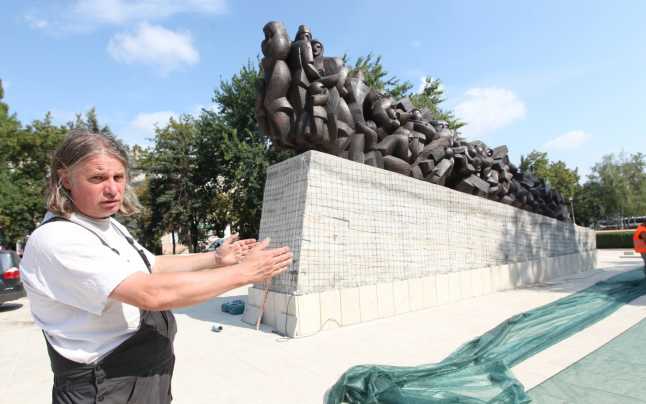“The train of pain”
The monument that is dedicated to the memory of the victims of the deportations of the communist regime (unofficially, also called the "Train of Pain") is a memorial that holds the memory of tens of thousands of Moldovans (Bessarabians) deported in the years 1940–1953 during the communist regime.
The location of the monument in the square of the Chisinau Railway Station has a special connotation: it was from here that most of the Bessarabians were forcibly taken to Siberia and Kazakhstan. Documentary materials about the deportees and their families are included in four volumes of the Memory Book. The volumes contain data on individuals subjected to repression (name, surname of the repressed, year of birth, place of origin, year and reason for repression, place of detention (deportation), data on rehabilitation) in the municipalities and districts of the Republic of Moldova. The documentary material is structured according to the administrative-territorial division of the Republic of Moldova until 12.11.1998. Within the district, the materials are distributed by communes, within the commune - in alphabetical order and respecting the chronology of repressions. To ensure maximum accessibility, the Memory Book has been digitized and encoded in a QR Code.

The monument is made by the sculptor Iurie Platon. The inauguration of the monument took place on August 23, 2013. The bronze sculpture is 3 meters high, 12 meters long and weighs 15 tons.
IURIE PLATON
Painter, ceramist, sculptor, organizer of numerous international projects of intercultural exchanges, teacher of art education,
visual artist with work in public and private collections from all around the world,
awarded with prestigious prizes and distinctions at contemporary art competitions.
Studies:
1974 – 1981 Republican High School of Fine Arts Igor Vieru, class of Professor Victor Marinescu, Chisinau
1982 – 1987 Institute of Arts, class of teachers Eve Mardna, Leo Rohlin, Tallinn, Estonia, Specialization: Fine and Applied Arts
Devotion:
1985 He made his creative debut with painting at the Youth Theater, Tallinn, Estonia
1987 The republican exhibition of decorative art participates with the work Memories
1987 Full member of the Association of Young Visual Artists and Art Critics of the USSR Union of Fine Artists
1991 Full member of the Union of Visual Artists of the Republic of Moldova
1997, 1998 Initiator and organizer of the International Symposium of small bronze sculpture, Chisinau
1996, up until now he continues to be an freelance visual artist in Germany and the Republic of Moldova
Teaching activity in art education:
1987 – 1996 P Professor at the Academy of Music, Theater and Fine Arts, Chisinau. He led the first class of graduates at the ceramics department, of which Oleg Dobrovolschi, Elena Mogorean, Ion Niţa, Vladimir Tabac integrated in the contemporary creative process.
2000, 2003, 2008 Professor of stone sculpture at the Summer Academy at the An der Copelschleuse Creation Center, Meppen, Germany
2005 Outdoor painting teacher at courses organized by the Imbert Gallery, Aix-en-Provance, France
Solo Exhibitions:
From the beginning of his artistic activity up until now, he carries out an extensive creative activity, accumulating in his record more than 60 personal and group exhibitions in the country and abroad: Argentina, Austria, Bulgaria, Czech Republic, France, Germany, Italy, Japan, Lithuania, Macedonia, Moldova, Romania, Russia, Spain, Sweden, Hungary.
Monumental works for public:
Argentina, Czech Republic, Germany, Republic of Moldova, Romania
Works in public and private collections:
Argentina, Czech Republic, Estonia, Germany, Republic of Moldova, Romania
Distinctions / scholarships:
1991 Youth Prize for Fine Arts, awarded by the Ministry of Youth and Sports of the Republic of Moldova
1994 Iulian Antonescu Museum Complex Award, Bacău, Romania
1996 Lotus Company Award, Romania - awarded at the exhibition-contest of contemporary art Salons of Moldova: Romania-Republic of Moldova
1997 First Prize of the Radio Free Europe Sculptors Symposium, Czech Republic
2000, 2003, 2008 Scholarship awarded by the An der Copelschleuse Creative Center, Meppen, Germany
2006 Scholarship awarded by the International Confederation of Visual Artists' Unions of Moscow at the Cité Internaionali des Arts, Paris, France
2009 Prize of the Union of Visual Artists of the Republic of Moldova
2009 First prize in the competition for the construction of the monument in memory of the victims of Stalinist reprisals, Chisinau
2011 Diploma of the Ministry of Culture of the Republic of Moldova at the International Biennial of Painting, Chisinau
















































